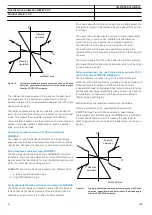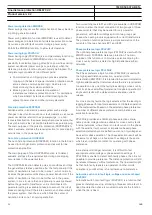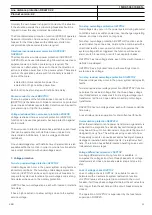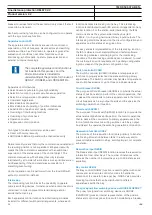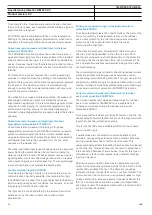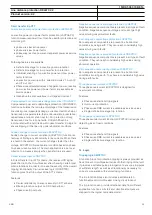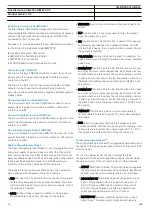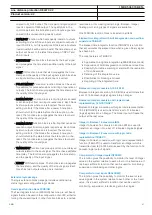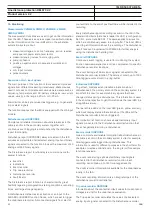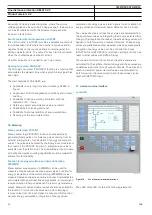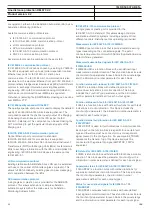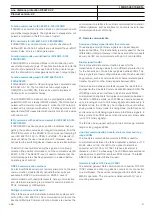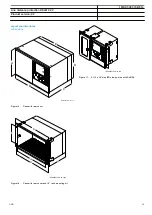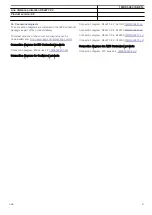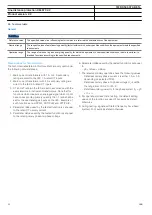
To accomplish this, three separate communication channels,
that is, one per phase, each capable of transmitting a signal in
each direction is required.
ZC1PPSCH can be completed with the current reversal and
WEI logic for phase segregated communication, when found
necessary in Blocking and Permissive overreaching schemes.
Current reversal and weak-end infeed logic for distance
protection ZCRWPSCH
The ZCRWPSCH function provides the current reversal and
weak end infeed logic functions that supplement the standard
scheme communication logic. It is not suitable for standalone
use as it requires inputs from the distance protection functions
and the scheme communications function included within the
terminal.
On detection of a current reversal, the current reversal logic
provides an output to block the sending of the teleprotection
signal to the remote end, and to block the permissive tripping at
the local end. This blocking condition is maintained long
enough to ensure that no unwanted operation will occur as a
result of the current reversal.
On verification of a weak end infeed condition, the weak end
infeed logic provides an output for sending the received
teleprotection signal back to the remote sending end and other
output(s) for local tripping. For terminals equipped for single-
and two-pole tripping, outputs for the faulted phase(s) are
provided. Undervoltage detectors are used to detect the faulted
phase(s).
Current reversal and weak-end infeed logic for phase
segregated communication ZC1WPSCH
Current reversal and weak-end infeed logic for phase
segregated communication (ZC1WPSCH) function is used to
prevent unwanted operations due to current reversal when
using permissive overreach protection schemes in application
with parallel lines where the overreach from the two ends
overlaps on the parallel line.
The weak-end infeed logic is used in cases where the apparent
power behind the protection can be too low to activate the
distance protection function. When activated, received carrier
signal together with local undervoltage criteria and no reverse
zone operation gives an instantaneous trip. The received signal
is also echoed back to accelerate the sending end.
Local acceleration logic ZCLCPSCH
To achieve fast clearing of faults on the whole line, when no
communication channel is available, local acceleration logic
(ZCLCPSCH) can be used. This logic enables fast fault clearing
and re-closing during certain conditions, but naturally, it can not
fully replace a communication channel.
The logic can be controlled either by the autorecloser (zone
extension) or by the loss-of-load current (loss-of-load
acceleration).
Scheme communication logic for residual overcurrent
protection ECPSCH
To achieve fast fault clearance of earth faults on the part of the
line not covered by the instantaneous step of the residual
overcurrent protection, the directional residual overcurrent
protection can be supported with a logic that uses
communication channels.
In the directional scheme, information of the fault current
direction must be transmitted to the other line end. With
directional comparison, a short operate time of the protection
including a channel transmission time, can be achieved. This
short operate time enables rapid autoreclosing function after
the fault clearance.
The communication logic module for directional residual current
protection enables blocking as well as permissive under/
overreaching, and unblocking schemes. The logic can also be
supported by additional logic for weak-end infeed and current
reversal, included in Current reversal and weak-end infeed logic
for residual overcurrent protection (ECRWPSCH) function.
Current reversal and weak-end infeed logic for residual
overcurrent protection ECRWPSCH
The Current reversal and weak-end infeed logic for residual
overcurrent protection (ECRWPSCH) is a supplement to
Scheme communication logic for residual overcurrent
protection ECPSCH.
To achieve fast fault clearing for all earth faults on the line, the
directional earth fault protection function can be supported with
logic that uses tele-protection channels.
This is why the IEDs have available additions to the scheme
communication logic.
If parallel lines are connected to common busbars at both
terminals, overreaching permissive communication schemes
can trip unselectively due to fault current reversal. This
unwanted tripping affects the healthy line when a fault is cleared
on the other line. This lack of security can result in a total loss of
interconnection between the two buses. To avoid this type of
disturbance, a fault current reversal logic (transient blocking
logic) can be used.
Permissive communication schemes for residual overcurrent
protection can basically operate only when the protection in the
remote IED can detect the fault. The detection requires a
sufficient minimum residual fault current, out from this IED. The
fault current can be too low due to an opened breaker or high-
positive and/or zero-sequence source impedance behind this
IED. To overcome these conditions, weak-end infeed (WEI)
echo logic is used. The weak-end infeed echo is limited to 200
ms to avoid channel lockup.
1MRK 506 372-BEN -
Line distance protection REL670 2.2
Product version: 2.2
38
ABB
Содержание RELION REL670
Страница 1: ...RELION 670 SERIES Line distance protection REL670 Version 2 2 Product guide...
Страница 149: ...149...





